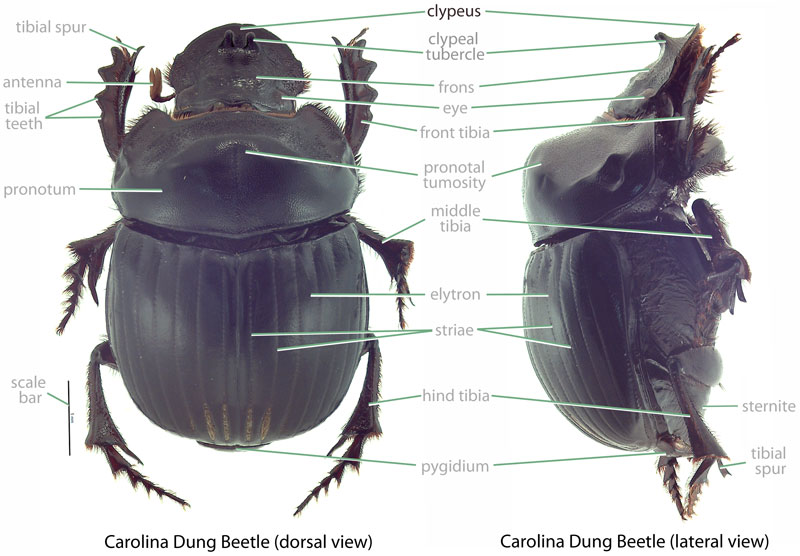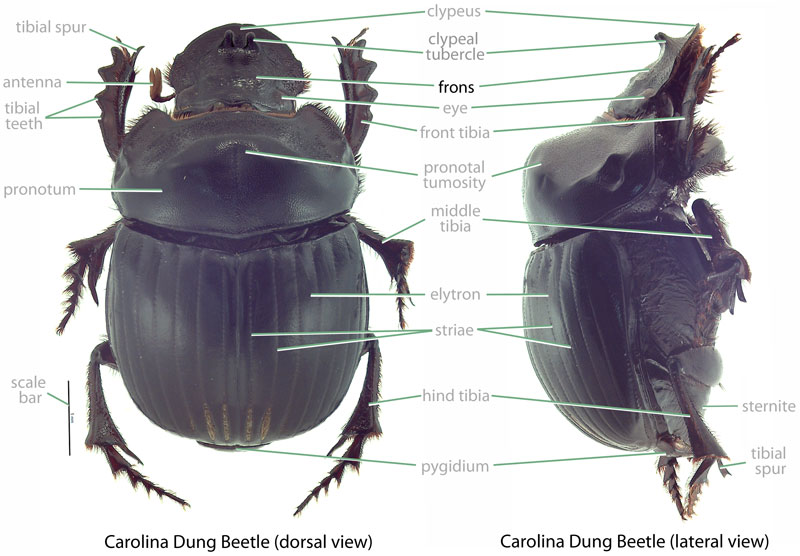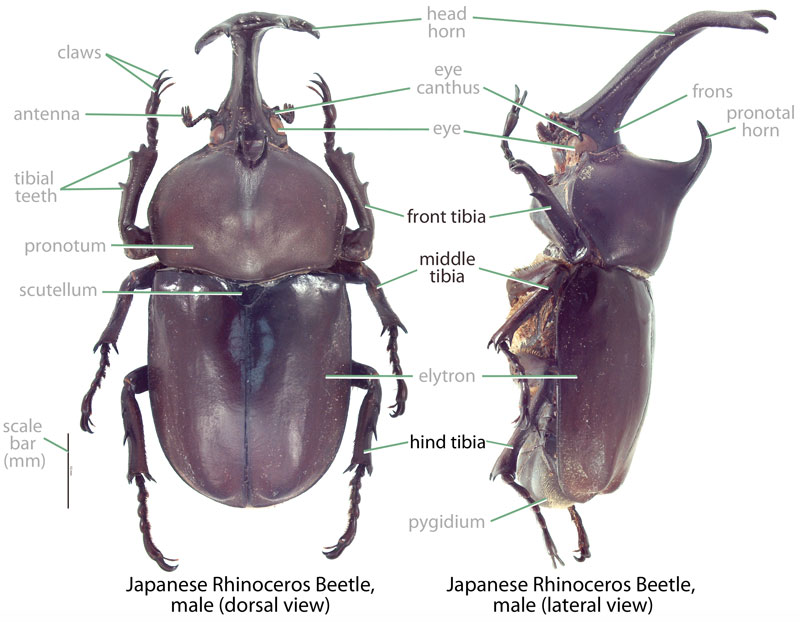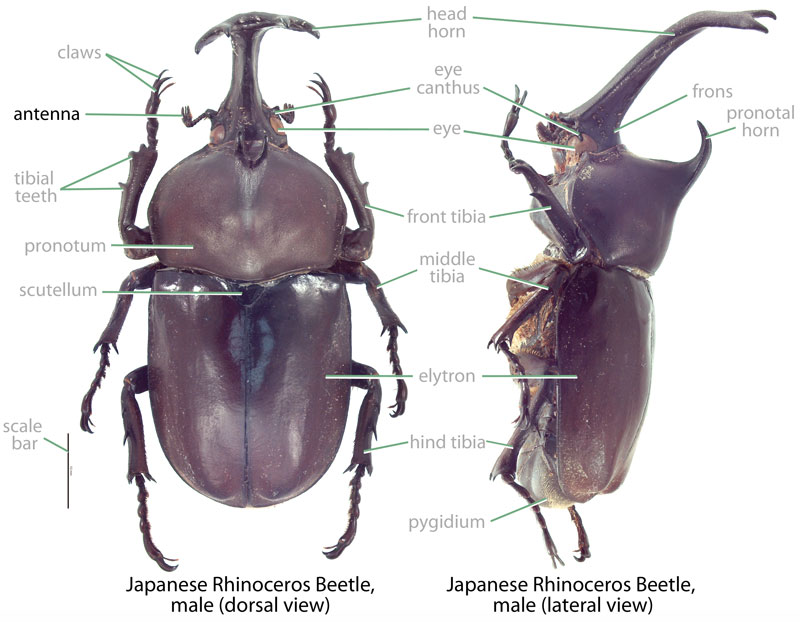Beneficial
none known
Family: Scarabaeidae Subfamily: Scarabaeinae Genus: Onitis Species: Onitis phartopus Lansberge, 1875
none available
Total body length 18.0–26.0 cm (0.71–1.02 in). Body shape subquadratesubquadrate:
somewhat quadrate in shape
posteriorly; may be caked in dried dung. Color dull black. Clypeusclypeus:
part of the head anterior to the frons; the most anterior portion in dorsal view
 rounded to weakly sinuatesinuate:
rounded to weakly sinuatesinuate:
gently curved (specifically of margins or edges); often in reference to the clypeus
. Fronsfrons:
part of the head generally positioned between the eyes (posterior to the clypeus and anterior to the vertex) and visible dorsally
 with weak, central tubercletubercle:
with weak, central tubercletubercle:
a small, conical knob or horn-like protuberance
. Front tibiatibia:
a segment of the leg articulated with the tarsus and femur
 of male elongate, curving ventrally and inward at apexapex:
of male elongate, curving ventrally and inward at apexapex:
point or edge furthest from the body
; female tibiatibia:
a segment of the leg articulated with the tarsus and femur
 less elongate and less curved than male; tarsitarsi:
less elongate and less curved than male; tarsitarsi:
the distal part of an insect leg attached to the tibia and consisting of five sub-segments in scarab beetles; bears the tarsal claws
lacking in both sexes. Middle leg with tibiatibia:
a segment of the leg articulated with the tarsus and femur
 of male abruptly expanded to a trapezoidal apexapex:
of male abruptly expanded to a trapezoidal apexapex:
point or edge furthest from the body
, female tibiatibia:
a segment of the leg articulated with the tarsus and femur
 less clearly trapezoidal. Hind trochantertrochanter:
less clearly trapezoidal. Hind trochantertrochanter:
a segment of the leg articulated with the femur and coxa
with spine on posteriorposterior:
towards the rear end; opposite of anterior
margin in male (lacking in female). Hind femurfemur:
segment of the leg that is articulated to the body by the trochanter and bears the tibia at the distal end
lacking spine-like process on posteriorposterior:
towards the rear end; opposite of anterior
margin in both sexes.
Undescribed. For Scarabaeinae (Ritcher, 1966Ritcher, 1966:
Ritcher P. 1966. White grubs and their allies: a study of North American scarabaeoid larvae. Oregon State University Monographs, Studies in Entomology 4: 1-219.): Grub C-shaped and hump-backed, cylindrical, cream-colored. Maxillamaxilla:
set of paired mouthparts located posterior to the mandibles
with galeagalea:
outer branch or lobe of the maxilla
 and lacinialacinia:
and lacinialacinia:
inner portion of the maxilla distinctly separate. AntennaeAntennae:
distinctly separate. AntennaeAntennae:
paired sensory organ on head, formed from numerous segments
 with 4 or 5 apparent segments. Distaldistal:
with 4 or 5 apparent segments. Distaldistal:
situated away from the point of articulation, thus usually furthest from the body
segment of antennaantenna:
paired sensory organ on head, formed from numerous segments
 much reduced in size. Epipharynxepipharynx:
much reduced in size. Epipharynxepipharynx:
lobe on the interior surface of the labrum or clypeus
with tormaetormae:
in scarab larvae, sclerotized structures on the ends of the clypeolateral suture extending towards the mesal line
united mesallymesally:
at or near midline of body
, anterioranterior:
the front or forward; opposite of posterior
phoba present. Anal opening surrounded by fleshy lobes. Legs 2-segmented.
Philippines. This species is known from the islands of the Philippines (Fullaway, 1921Fullaway, 1921:
Fullaway O. 1921. Horn fly control. The Hawaiian Forester and Agriculturist: Quarterly Magazine of Forestry, Entomology, Plant Inspection and Animal Industry 18: 219-221. full text (accessed 2015)).
None. Onitis spp. feed on dung as both adults and larvaelarvae:
the immature form of an insect; in scarabs, also called grub or white grub; preceded by the egg stage, followed by the pupal stage
 (Edwards and Aschenborn, 1987Edwards and Aschenborn, 1987:
(Edwards and Aschenborn, 1987Edwards and Aschenborn, 1987:
Edwards P and Aschenborn H. 1987. Patterns of nesting and dung burial in Onitis dung beetles: implications for pasture productivity and fly control. Journal of Applied Ecology 24: 837-851. full text (accessed 2015)).
Poorly known. (Edwards and Aschenborn, 1987Edwards and Aschenborn, 1987:
Edwards P and Aschenborn H. 1987. Patterns of nesting and dung burial in Onitis dung beetles: implications for pasture productivity and fly control. Journal of Applied Ecology 24: 837-851. full text (accessed 2015)): Related species of Onitis burrow under fresh dung and create a vertical tunnel lined with dung. Male and female beetles cooperate to transport dung pieces down the burrow where they are shaped into sausage-like masses. An egg (or eggs) is deposited into each of the dung sausages, and larval development occurs within the brood mass.
None. This species recycles dung and is beneficial for ranching and farming in Hawaii. Being a dung feeder, this species poses no threat to crop or ornamental plants. Additionally, this species is not a threat to native dung beetles because none are known from Hawaii or Guam.
Recorded, not established. This species was brought to Hawaii for evaluation of its potential for biocontrol of the horn fly (Haematobia irritans), a biting pest of livestock. However, imported specimens failed to thrive and were not released (Fullaway, 1921Fullaway, 1921:
Fullaway O. 1921. Horn fly control. The Hawaiian Forester and Agriculturist: Quarterly Magazine of Forestry, Entomology, Plant Inspection and Animal Industry 18: 219-221. full text (accessed 2015)).
Not established or recorded. There are no records of this species from Guam.
In Hawaii, this species was intentionally imported.
Three species of Onitis are recorded from Hawaii (none are known from Guam). Onitis phartopus can be separated from the other Onitis species by examination of the middle tibiatibia:
a segment of the leg articulated with the tarsus and femur
 (O. phartopus male with an abruptly expanded, trapezoidal apexapex:
(O. phartopus male with an abruptly expanded, trapezoidal apexapex:
point or edge furthest from the body
versus a gradually expanded, triangulate apexapex:
point or edge furthest from the body
in O. alexis and O. vanderkelleni), hind trochantertrochanter:
a segment of the leg articulated with the femur and coxa
(with a spine in Onitis phartopus versus O. alexis and O. vanderkelleni that lack a spine), hind femurfemur:
segment of the leg that is articulated to the body by the trochanter and bears the tibia at the distal end
(O. phartopus lacking femoral spine versus O. alexis and O. vanderkelleni males with spine on the posteriorposterior:
towards the rear end; opposite of anterior
margin), and color (O. phartopus is dull black versus dark greenish with brown elytraelytra:
the hardened and chitinous wing-cover of a beetle that protect and overlie the flight wing
in O. alexis).
Onitis sphinx Illiger
Report your observation of this beneficial species at our iNaturalist project.